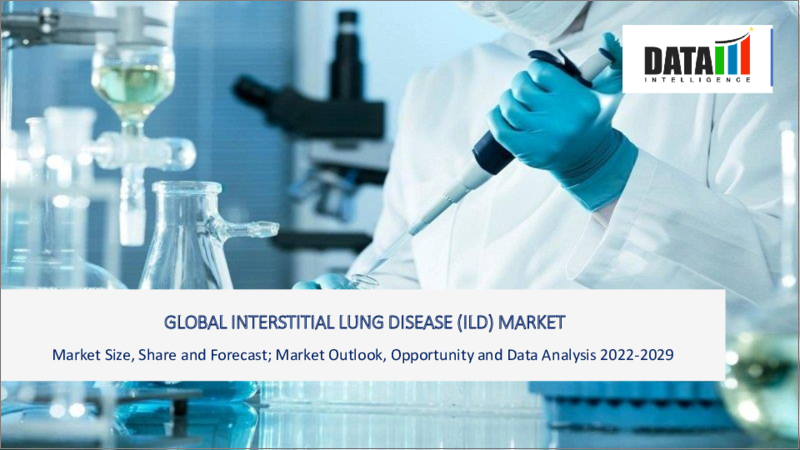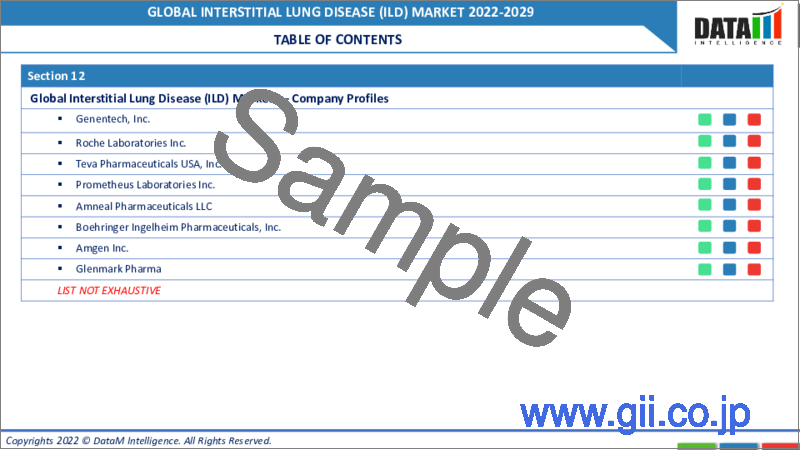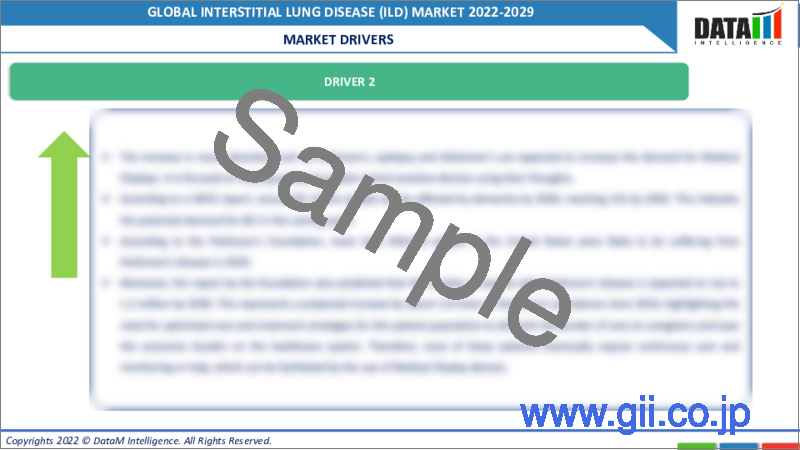|
|
市場調査レポート
商品コード
1077276
間質性肺疾患(ILD)の世界市場 - 2022年~2029年Global Interstitial lung disease (ILD) Market - 2022-2029 |
||||||
|
● お客様のご希望に応じて、既存データの加工や未掲載情報(例:国別セグメント)の追加などの対応が可能です。 詳細はお問い合わせください。 |
|||||||
| 間質性肺疾患(ILD)の世界市場 - 2022年~2029年 |
|
出版日: 2022年05月19日
発行: DataM Intelligence
ページ情報: 英文 160 Pages
納期: 約2営業日
|
- 全表示
- 概要
- 目次
目次
第1章 調査手法と範囲
第2章 市場の定義と概要
第3章 エグゼクティブサマリー
- 疾患タイプ別、市場内訳
- 薬剤タイプ別、市場内訳
- 流通チャネル別、市場内訳
- 地域別、市場内訳
第4章 市場力学
- 市場に影響を与える要因
- 促進要因
- 抑制要因
- 市場機会
- 影響分析
第5章 業界分析
- サプライチェーン分析
- 価格分析
- アンメットニーズ
第6章 COVID-19分析
第7章 疾患タイプ別
- イントロダクション
- 市場規模分析、および前年比成長分析(%)、疾患タイプ別
- 市場魅力指数、疾患タイプ別
- 間質性肺炎
- イントロダクション
- 市場規模分析、100万米ドル(2020年~2029年)、および対前年比成長分析(%)(2021年~2029年)
- 特発性肺線維症
- 非特異的間質性肺炎
- 過敏性肺炎
- 特発性器質化肺炎(COP)
- 急性間質性肺炎
- その他
第8章 薬剤タイプ別
- イントロダクション
- 市場規模分析、および前年比成長分析(%)、薬剤タイプ別
- 市場魅力指数、薬剤タイプ別
- 経口コルチコステロイド
- プレドニゾン
- その他
- イントロダクション
- 市場規模分析、100万米ドル(2020年~2029年)、および対前年比成長分析(%)(2021年~2029年)
- 免疫抑制
- 抗線維化薬
- その他
第9章 流通チャネル別
- イントロダクション
- 市場規模分析、および前年比成長分析(%)、流通チャネル別
- 市場魅力指数、流通チャネル別
- 院内薬局
- イントロダクション
- 市場規模分析、100万米ドル(2020年~2029年)、および対前年比成長分析(%)(2021年~2029年)
- 小売薬局
- オンライン薬局
- その他
第10章 地域別
- イントロダクション
- 市場規模分析、100万米ドル(2020年~2029年)、および対前年比成長分析(%)(2021年~2029年)、地域別
- 市場魅力指数、地域別
- 北米
- 欧州
- 南米
- アジア太平洋
- 中東・アフリカ
第11章 競合情勢
- 主な発展と戦略
- 企業シェア分析
- 製品のベンチマーク
- 注目すべき主要企業のリスト
第12章 企業プロファイル
- Horizon Pharma USA, Inc.
- Novartis Pharmaceuticals Corporation
- Genentech, Inc.
- Roche Laboratories Inc.
- Teva Pharmaceuticals USA, Inc.
- Prometheus Laboratories Inc.
- Amneal Pharmaceuticals LLC
- Boehringer Ingelheim Pharmaceuticals, Inc.
- Amgen Inc.
第13章 世界の間質性肺疾患(ILD)市場-DataM
Market Overview
The global interstitial lung disease (ILD) market is expected to grow at a CAGR of 6.1% during the forecasting period (2022-2029).
Interstitial lung disease is caused by long-term exposure to hazardous materials, such as asbestos or coal dust, or it can be caused by an auto-immune disease such as rheumatoid arthritis. Scarring of the lungs is usually irreversible once it develops. A dry cough is one of the symptoms. Short breath can occur at rest or after effort, and treatment varies depending on the underlying reason. However, steroids are frequently used.
Market Dynamics
Advancements in the diagnosis, prognosis, and treatment response for progressive fibrosing interstitial lung disease are expected to drive market growth.
Idiopathic pulmonary fibrosis (IPF) is the most common progressive fibrosing ILD (PF-ILD); PF-ILD affects many patients with other ILD subtypes. Biomarker investigation to date has identified several molecular markers that predict relevant ILD endpoints, including disease presence, prognosis, and treatment response. Recent research has shown that modeling plasma biomarkers in aggregate have more potential. When modeled with clinical features, Doyle et al. found that matrix metalloproteinase 7 (MMP-7), pulmonary and activation-related chemokine (PARC), and surfactant protein D (SP-D) accurately predicted ILD in individuals with rheumatoid arthritis (RA). White and colleagues used a similar approach to create and validate a protein prediction score to identify IPF from healthy controls and most alternative ILDs, utilizing plasma MMP-7, SP-D, and osteopontin concentrations.
Additionally, Sanders et colleagues. recently demonstrated that biomarkers hold potential for detecting early ILD, also known as interstitial lung abnormalities (ILAs). GDF15 and four additional plasma biomarkers are elevated in community-dwelling persons with ILAs, with GDF15 being verified in a separate cohort. These findings suggest that plasma biomarkers may one day be used to screen for ILD without intrusive testing. Thus, the market is expected to drive in the forecast period from the above statements.
Restraint:
Lack of awareness associated with interstitial lung disease and side effects associated with the drugs are the factors the market is expected to get hampered in the forecast period.
COVID-19 Impact Analysis
The COVID-19 pandemic has moderately impacted healthcare systems and the market. Patients with ILD are more susceptible to COVID-19 and have a higher risk of developing the severe disease than those who do not. In one study, patients with COVID-19 ILD had a 49 percent overall mortality rate; poor lung function and obesity increased the risk of death. In another study, patients with ILD and COVID-19 had a higher risk of severe illness and death than age, sex and race-matched controls without ILD. Nonsurvivors in this small group are older, had lower DLCO, and had a higher proportion of a typical interstitial pneumonia pattern on computed tomography (CT) scans; earlier ILD-directed therapy did not affect outcomes.
Moreover, the lack of objective indicators of disease development, such as pulmonary function testing (PFT) and 6-minute walk (6MW) tests, led to inadequate clinical assessment during Coronavirus. Additionally, during the pandemic, rapid changes in global health disturbed the usual care of patients with ILD. Healthcare institutions have evolved several practices to counteract these consequences, including delivering care to patients via telemedicine visits and nurse home visits. Thus, the above statements affected the market, and the market is expected to boost in the forecast period.
Segment Analysis
Anti-Fibrotic Medication segment is expected to hold the largest market share in interstitial lung disease (ILD) market
The anti-fibrotic medication segment is expected to dominate in 2021. The segment benefits because it is shown in clinical trials to slow down the rate of fibrosis or scarring in the lungs. These drugs are approved for patients with mild, moderate and severe IPF. For instance, the US Food and Drug Administration has approved two drugs to treat persons with idiopathic pulmonary fibrosis (IPF). People with scleroderma-related ILD or other kinds of progressive pulmonary fibrosis can also use nintedanib (Ofev) and Esbriet (pirfenidone). Therefore, it has increased the clinical trials and product approvals. Thus, the market segment is expected to hold the largest market share in the forecast period from the above statements.
Geographical Analysis
North America region holds the largest market share in the global interstitial lung disease (ILD) market
In 2021, North America accounted for the highest revenue share. The increasing prevalence of Pulmonary Fibrosis, rising geriatric population, well-established infrastructure, increasing clinical trials and number of product approvals in the region are some factors the market is expected to boost in the forecast period. For instance, Idiopathic pulmonary fibrosis is more common than we once thought, with up to 207,000 people affected in the United States and about 58,000 new cases diagnosed each year. It is more common in men than women and mostly affects people over 50 years of age. Moreover, The U.S. Food and Drug Administration (FDA) approved Actemra/RoActemra (tocilizumab) subcutaneous injection for slowing the rate of decline in pulmonary function in adult patients with systemic sclerosis-associated interstitial lung disease (SSc-ILD), a debilitating condition with limited treatment options, in March 2021, according to F. Hoffmann-La Roche Ltd, a biotech company. The first biologic drug approved by the US FDA for treating the condition is Actemra/RoActemra. Thus, the North American region is expected to hold the largest market share in the forecast period from the above statements.
Competitive Landscape
Major key players in the interstitial lung disease (ILD) market are Horizon Pharma USA, Inc., Novartis Pharmaceuticals Corporation, Genentech, Inc., Roche Laboratories Inc., Teva Pharmaceuticals USA, Inc., Prometheus Laboratories Inc., Amneal Pharmaceuticals LLC, Boehringer Ingelheim Pharmaceuticals, Inc. and Amgen Inc.
Genentech, Inc.:
Overview:
F. Hoffmann-La Roche Ltd is the parent company of Genentech Inc., a biotechnology company based in the United States that became a subsidiary of Roche in 2009. The company is dedicated to pioneering science to discover and develop medicines for people suffering from serious and life-threatening diseases. In the United States, Roche and Genentech merged their pharmaceutical operations. The Genentech campus in South San Francisco is now the headquarters for Roche's pharmaceutical operations in the United States. Genentech Research and Early Development is a separate entity within Roche. Roche Holding Ltd. owns 66 percent of Genentech but allows it to operate independently. Genentech discovers, develops, manufactures, and sells human pharmaceuticals to meet critical medical needs.
Product Portfolio:
CELLCEPT (MYCOPHENOLATE MOFETIL): Mycophenolate is used to reduce inflammation, which can contribute to your symptoms of breathlessness and reduce your ability to exercise.
Why Purchase the Report?
Visualize the composition of the interstitial lung disease (ILD) market segmentation by disease type, drug type, distribution channel, and region highlighting the key commercial assets and players.
Identify commercial opportunities in interstitial lung disease (ILD) market by analyzing trends and co-development deals.
Excel data sheet with thousands of data points of interstitial lung disease (ILD) market- level 4/5 segmentation.
PDF report with the most relevant analysis cogently put together after exhaustive qualitative interviews and in-depth market study.
Product mapping in excel for the key product of all major market players
The global interstitial lung disease (ILD) market report would provide an access to an approx. 45+market data table, 40+figures and 160pages.
Target Audience
Service Providers/ Buyers
Industry Investors/Investment Bankers
Education & Research Institutes
Research Professionals
Emerging Companies
Manufacturers
Table of Contents
1. Methodology and Scope
- 1.1. Research Methodology
- 1.2. Research Objective and Scope of the Report
2. Market Definition and Overview
3. Executive Summary
- 3.1. Market Snippet by Disease Type
- 3.2. Market Snippet by Drug Type
- 3.3. Market Snippet by Distribution channel
- 3.4. Market Snippet by Region
4. Market Dynamics
- 4.1. Market Impacting Factors
- 4.1.1. Drivers
- 4.1.1.1. Advancements in the diagnosis, prognosis, and treatment response for progressive fibrosing interstitial lung disease are expected to drive market growth.
- 4.1.2. Restraints:
- 4.1.2.1. Side effects caused by the drugs are expected to hamper the market growth.
- 4.1.3. Opportunity
- 4.1.4. Impact Analysis
- 4.1.1. Drivers
5. Industry Analysis
- 5.1. Supply Chain Analysis
- 5.2. Pricing Analysis
- 5.3. Unmet Needs
6. COVID-19 Analysis
- 6.1. Analysis of Covid-19 on the Market
- 6.1.1. Before COVID-19 Market Scenario
- 6.1.2. Present COVID-19 Market Scenario
- 6.1.3. After COVID-19 or Future Scenario
- 6.2. Pricing Dynamics Amid Covid-19
- 6.3. Demand-Supply Spectrum
- 6.4. Government Initiatives Related to the Market During Pandemic
- 6.5. Manufacturers Strategic Initiatives
- 6.6. Conclusion
7. By Disease Type
- 7.1. Introduction
- 7.1.1. Market Size Analysis, and Y-o-Y Growth Analysis (%), By Disease Type
- 7.1.2. Market Attractiveness Index, By Disease Type Segment
- 7.2. Interstitial Pneumonia*
- 7.2.1. Introduction
- 7.2.2. Market Size Analysis, US$ Million, 2020-2029 and Y-o-Y Growth Analysis (%), 2021-2029
- 7.3. Idiopathic Pulmonary Fibrosis
- 7.4. Nonspecific Interstitial Pneumonitis
- 7.5. Hypersensitivity Pneumonitis
- 7.6. Cryptogenic Organizing Pneumonia (COP)
- 7.7. Acute Interstitial Pneumonitis
- 7.8. Others
8. By Drug Type
- 8.1. Introduction
- 8.1.1. Market Size Analysis, and Y-o-Y Growth Analysis (%), By Drug Type
- 8.1.2. Market Attractiveness Index, By Drug Type Segment
- 8.2. Oral Corticosteroids*
- 8.2.1. Prednisone
- 8.2.2. Others
- 8.2.3. Introduction
- 8.2.4. Market Size Analysis, US$ Million, 2020-2029 and Y-o-Y Growth Analysis (%), 2021-2029
- 8.3. Immune Suppressing
- 8.3.1. Mycophenolate mofetil (CellCept) or mycophenolic acid (Myfortic)
- 8.3.2. Azathioprine (Imuran)
- 8.3.3. Cyclophosphamide (Cytoxan)
- 8.3.4. Rituximab (Rituxan)
- 8.3.5. Others
- 8.4. Anti-Fibrotic Medication
- 8.4.1. Nintedanib (Ofev)
- 8.4.2. Pirfenidone (Esbriet)
- 8.4.3. Others
- 8.5. Others
9. By Distribution Channel
- 9.1. Introduction
- 9.1.1. Market Size Analysis, and Y-o-Y Growth Analysis (%), By Distribution Channel
- 9.1.2. Market Attractiveness Index, By Distribution Channel Segment
- 9.2. Hospital Pharmacies*
- 9.2.1. Introduction
- 9.2.2. Market Size Analysis, US$ Million, 2020-2029 and Y-o-Y Growth Analysis (%), 2021-2029
- 9.3. Retail Pharmacies
- 9.4. Online Pharmacies
- 9.5. Others
10. By Region
- 10.1. Introduction
- 10.1.1. Market Size Analysis, US$ Million, 2020-2029 and Y-o-Y Growth Analysis (%), 2021-2029, By Region
- 10.1.2. Market Attractiveness Index, By Region
- 10.2. North America
- 10.2.1. Introduction
- 10.2.2. Key Region-Specific Dynamics
- 10.2.3. Market Size Analysis, and Y-o-Y Growth Analysis (%), By Disease Type
- 10.2.4. Market Size Analysis, and Y-o-Y Growth Analysis (%), By Drug Type
- 10.2.5. Market Size Analysis, and Y-o-Y Growth Analysis (%), By Distribution Channel
- 10.2.6. Market Size Analysis, and Y-o-Y Growth Analysis (%), By Country
- 10.2.6.1. U.S.
- 10.2.6.2. Canada
- 10.2.6.3. Mexico
- 10.3. Europe
- 10.3.1. Introduction
- 10.3.2. Key Region-Specific Dynamics
- 10.3.3. Market Size Analysis, and Y-o-Y Growth Analysis (%), By Disease Type
- 10.3.4. Market Size Analysis, and Y-o-Y Growth Analysis (%), By Drug Type
- 10.3.5. Market Size Analysis, and Y-o-Y Growth Analysis (%), By Distribution Channel
- 10.3.6. Market Size Analysis, and Y-o-Y Growth Analysis (%), By Country
- 10.3.6.1. Germany
- 10.3.6.2. U.K.
- 10.3.6.3. France
- 10.3.6.4. Italy
- 10.3.6.5. Spain
- 10.3.6.6. Rest of Europe
- 10.4. South America
- 10.4.1. Introduction
- 10.4.2. Key Region-Specific Dynamics
- 10.4.3. Market Size Analysis, and Y-o-Y Growth Analysis (%), By Disease Type
- 10.4.4. Market Size Analysis, and Y-o-Y Growth Analysis (%), By Drug Type
- 10.4.5. Market Size Analysis, and Y-o-Y Growth Analysis (%), By Distribution Channel
- 10.4.6. Market Size Analysis, and Y-o-Y Growth Analysis (%), By Country
- 10.4.6.1. Brazil
- 10.4.6.2. Argentina
- 10.4.6.3. Rest of South America
- 10.5. Asia Pacific
- 10.5.1. Introduction
- 10.5.2. Key Region-Specific Dynamics
- 10.5.3. Market Size Analysis, and Y-o-Y Growth Analysis (%), By Disease Type
- 10.5.4. Market Size Analysis, and Y-o-Y Growth Analysis (%), By Drug Type
- 10.5.5. Market Size Analysis, and Y-o-Y Growth Analysis (%), By Distribution Channel
- 10.5.6. Market Size Analysis, and Y-o-Y Growth Analysis (%), By Country
- 10.5.6.1. China
- 10.5.6.2. India
- 10.5.6.3. Japan
- 10.5.6.4. Australia
- 10.5.6.5. Rest of Asia Pacific
- 10.6. Middle East and Africa
- 10.6.1. Introduction
- 10.6.2. Key Region-Specific Dynamics
- 10.6.3. Market Size Analysis, and Y-o-Y Growth Analysis (%), By Disease Type
- 10.6.4. Market Size Analysis, and Y-o-Y Growth Analysis (%), By Drug Type
- 10.6.5. Market Size Analysis, and Y-o-Y Growth Analysis (%), By Distribution Channel
11. Competitive Landscape
- 11.1. Key Developments and Strategies
- 11.2. Company Share Analysis
- 11.3. Product Benchmarking
- 11.4. List of Key Companies to Watch
12. Company Profiles
- 12.1. Horizon Pharma USA, Inc.
- 12.1.1. Company Overview
- 12.1.2. Product Portfolio and Description
- 12.1.3. Key Highlights
- 12.1.4. Financial Overview
- 12.2. Novartis Pharmaceuticals Corporation
- 12.3. Genentech, Inc.
- 12.4. Roche Laboratories Inc.
- 12.5. Teva Pharmaceuticals USA, Inc.
- 12.6. Prometheus Laboratories Inc.
- 12.7. Amneal Pharmaceuticals LLC
- 12.8. Boehringer Ingelheim Pharmaceuticals, Inc.
- 12.9. Amgen Inc.
LIST NOT EXHAUSTIVE
13. Global Interstitial lung disease (ILD) Market - DataM
- 13.1. Appendix
- 13.2. About Us and Applications
- 13.3. Contact Us




